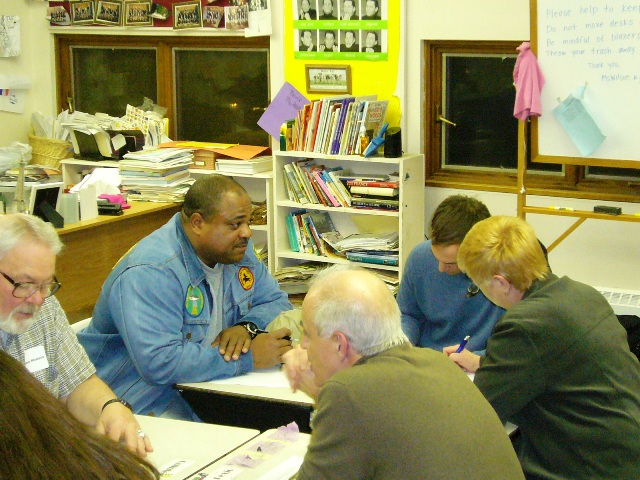Making a statement about history

By Matt Blanchard
For PlanPhilly
Everyone agrees “history” should be part of a revitalized Delaware waterfront, but how? After five decades of road construction and building demolitions along the river, what remains of Philadelphia’s maritime history?
This question dogged participants during Monday night’s Principles Session at St. Peter’s School in Society Hill. The bustling wharves of 1800 and the ironbound shipyards of 1900 are long gone. We are left with overgrown piers and a few ships at Penn’s Landing to speak for our romantic port-city past.
Yet by working together, citizens were able to craft some design concepts around the value of history.
These concepts will be used on March 1-3, when a team of world-class architects and designers will gather with citizens at the Seaport Museum to create the impressionistic beginnings of the final Central Delaware Riverfront Plan.
The concepts are as follows:
Historic Scale: Everywhere else in the city, Philadelphia’s history is experienced through its narrow, neighborly street grid. If that dense urban fabric can be extended to the waterfront, it will restore Philadelphia to its historic wellspring, the river.
“Most of the history has been torn down,” said resident Peter Angelides. “But history is experienced in the walkable streets … What’s left of history is the Philadelphia scale.”
If once again pedestrians can ramble down through side streets to the river’s edge, past shops and workshops, the best part of our past will be reborn.
Celebrating the Working Port: Though rarely seen by outsiders, Philadelphia’s port facilities are alive and well in Tioga, South Philadelphia, and a few points in between. Providing view points to port activities, perhaps in the form of viewing platforms or river tours, would raise the port’s profile and bring back some of the port atmosphere.
New Uses for the 1920s Piers: Citizens recommended highly public uses for the most evocative of the surviving maritime structures: the Beaux Arts-style piers (pier 84 is one example).
Greater Effort to Provide Interpretive Markers: With so much history lost, citizens imagined plaques, signs, mini-museums and monuments to announce aspects of Philadelphia history, perhaps along a waterfront trail. Without providing these simple aides, truly historic features such as neighborhood names, archeological sites and important events are in danger of being forgotten.
Restore Sight Lines to the River: Views can also be historic, and a view to the river down Philadelphia’s streets will do much to restore the city to its river.Cultivating Traditions: By capitalizing on traditions like the Mummer’s 2 Street parades, we can weave a connection between neighborhoods and the waterfront. Participants imagined little-known histories and traditions along the river that could serve to draw life back to the river. One example given was fishing; once a major industry, this activity survives in pockets despite the lack of river access.
Beyond the group work, individuals offered further food for thought.
Connie Freeman of Center City urged planners to remember the seedy side of life that once thrived along the waterfront. “I’m for supporting the tattoo parlors and the strip clubs,” she said. “I myself haven’t had a drink for 15 years, but I feel those places are valuable. We’ve made everything so hygienic and politically correct, it doesn’t look like reality.”
Harriet Mishkin of Society Hill Towers wondered why the Penn’s Landing area devoted so much space to monuments for the Korean War and Vietnam War and so little to the history of the area. “There’s so much real history here,” she said, envisioning a variety of mini-monuments that could conjure a sense for the maritime past.
Lori Dillard-Rech, director of the Betsy Ross House, seconded the idea of historical interpretation, bringing up the little-known revolutionary battle at Fort Mifflin, where the heroic garrison managed to keep the British fleet at bay for days in 1777 while being pounded with artillery. Closer to Center City, Dillard-Rech mentioned the Association Battery, a 27-gun fortification at the foot of Wharton Street.
“Our port itself is extremely rich in history,” she said. “But I don’t think Philadelphians think of this as a port city at all.”
Matt Blanchard is a former Philadelphia Inquirer reporter who lives in and writes from Philadelphia.
WHYY is your source for fact-based, in-depth journalism and information. As a nonprofit organization, we rely on financial support from readers like you. Please give today.






